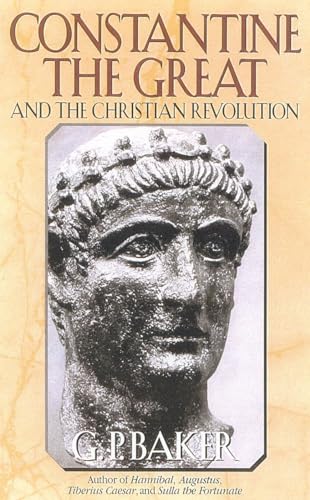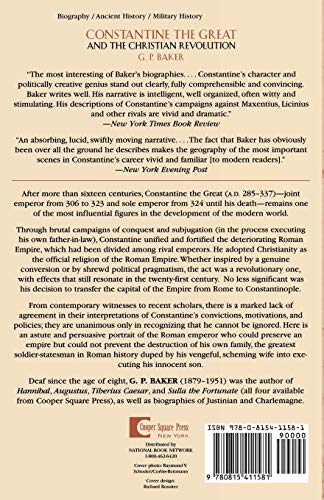Hey folks, Steve here! Today, I’m reviewing the flashy, wild, and sometimes eyebrow-raising history book called Constantine the Great. Now, I know what you’re thinking—old Roman emperors usually sound like the type of guys who would make you snore at a museum. But trust me, this book can be a wild ride. From sword fights and sneaky palace drama to possibly the boldest PR campaign of the ancient world (hello, legalizing Christianity), there’s a lot to unpack. I’ll give you the good, the bad, and even the bits that made me spill my coffee from laughing (and once from confusion). So, buckle up as I share my honest thoughts before you decide if this one is worth your bookshelf space!
Constantine the Great — A Quick Glance
In a nutshell
If you like your history bold, with a pinch of drama and a dash of politics, this biography hits the spot. Written by a seasoned historian (who I picture wearing tweed and probably eating olives as they wrote), Constantine the Great takes you through the wild world of Rome in the 4th century. It’s a non-fiction piece, but don’t worry, the author keeps it lively — nobody nods off here, unless you doze off in church, which, by the way, wasn’t so safe before Constantine came along.
The book wrestles with big themes like faith, power, and what happens when your mom tells you that you’re literally chosen by God. You’ll get a front-row seat to Constantine’s rise, his surprising religious moves, and the way he shook up the Roman rulebook. Even if you slept through history class (I did, sorry Mrs. Parker), you’ll find this one easy to follow and packed with juicy details. Just don’t expect every answer — mysteries and debate still swirl around ol’ Constantine!
How Constantine the Great Climbed the Ladder to Power
Let me tell you, Constantine the Great did not just stroll into history wearing a shiny helmet and a purple robe. No, my friends, his early days were packed with more drama than my family’s last Christmas dinner. Born in what is now Serbia, Constantine had to struggle from day one. His dad was a Roman officer, and his mom, Helena, came from far humbler roots. When you have a military dad and a saintly mom, I guess you end up slaying both dragons and hearts.
After spending his youth zig-zagging all over the Roman Empire and watching his dad climb up the ranks, Constantine started catching the scent of power. When his father died in 306 AD, Constantine’s own troops shouted his name like he was a rockstar called to the stage. They wanted him as emperor. Easy, right? Wrong! The Roman Empire at the time had more emperors than my kitchen has dirty mugs. Cue the Roman Tetrarchy: four emperors who were supposed to share power, but actually just made things messier.
Constantine, though, was not about to share the limelight. He fought rivals left and right and ended up in quite a few scraps. His most famous flex was at the Battle of the Milvian Bridge in 312 AD. Before the fight, he supposedly had a divine vision, slapped a Christian symbol on his army’s shields, and then totally wrecked his enemy, Maxentius. After that, Constantine was not just any emperor—he was the emperor who believed God had his back. That gave him quite the edge.
But what did Constantine the Great do once he had all this power? Get ready, because next, I’ll roll out his wild influence on early Christianity like a fresh papyrus scroll!
How Constantine the Great Changed Early Christianity
If you think one guy can’t change a whole religion, you haven’t met Constantine the Great. Well, none of us have. He lived way back in the 4th century. But I swear, if time travel was real, I’d buy him a coffee just to ask what he was thinking. Before Constantine, Christianity was like that unpopular band only your cousin listened to. After Constantine? Instant main stage at Coachella! Suddenly, the faith went from dodging Roman soldiers to being best pals with the emperor.
One huge impact was the Edict of Milan in 313 AD. Constantine was like, “Okay folks, let’s stop throwing Christians to lions. From now on, you can believe what you like without worrying about being eaten.” Churches popped up everywhere. Sundays got an upgrade and became the official day off—thanks, Constantine! And he made sure that bishops had better job security than my old gig at the burger place.
Another thing: Constantine helped settle arguments about what Christians should believe. There were more feuds than at a family reunion. He called the Council of Nicaea in 325 AD, so the church could finally agree on stuff. Sort of. At least people stopped bickering about the nature of Christ at every meal (probably).
But here’s the rub. Some say Constantine’s motives were more about power than faith. After all, making your empire united with one big religion is a smart move—even if you don’t actually understand half the sermons. Either way, he turned Christianity into the ultimate “in” crowd.
And you don’t want to miss what he did next—because next up, we’re talking about his wild political maneuvers and crafty reforms. Buckle up, it gets complicated!
Constantine the Great: Mastermind of Political Power Plays and Bold Reforms
Let’s talk about the political genius of Constantine the Great. The guy wasn’t just on the throne for his sharp jawline. Nope, he worked that imperial chessboard like he was playing for pizza night. First off, he moved the capital from Rome to Byzantium (later called Constantinople), which—let’s be real—wasn’t just for the view. He understood that Rome was yesterday’s news and the east was where things were happening. Moving the capital put him smack in the middle of all the action. My buddy Greg still says it was the most aggressive ‘changing the Wi-Fi password’ move in history.
But that was just the start. Constantine reworked the government by slicing up the empire into smaller, easier-to-manage bits. This was like organizing your sock drawer after years of just tossing everything in. It actually worked! Regional leaders could not just twiddle their thumbs anymore. He also started the Solidus, a gold coin. This wasn’t just pocket change; it helped stop inflation and kept the economy from falling apart like my last IKEA bookshelf.
Cons? Well, his reforms made things trickier for average folks. There were new taxes and laws, and let’s just say, not everyone was thrilled. My friend Julia said it was like signing up for a gym membership—sounds good until you realize the monthly fee never goes away.
Now, with Constantine’s grand moves shaking up the empire, it’s time to peek behind the curtain: just how accurate is this tale, and what kind of narrative magic does the book whip up? Buckle up, because the next section is about to get real historic and a tad meta!
How Accurate (and Fun) Is ‘Constantine the Great’?
Historical books can be as dry as a stale cracker. Lucky for us, ‘Constantine the Great’ knows how to add some flavor—or at least tries. The author sticks close to facts, but isn’t afraid to add a little drama. Constantine’s wild family life? Covered. His big battles? In detail. Even his odd fashion choices (yes, Emperor Bling was a thing) get a shoutout. You can tell the author did their homework. Dates and names come flying at you, but in a way that feels more like a chat at the pub instead of a dusty lecture.
But, let’s be honest, sometimes it feels like the author’s got a crush on Constantine. The book winks at some of his, shall we say, questionable decisions. Poisonings? Glossed over. That weird sun god phase? Blink and you’ll miss it. The story skips over some rougher patches like me skipping leg day at the gym. Still, I got a good sense of what made Constantine tick, and why he mattered so much to history.
As for style, it’s easy to read with short chapters and stories that kept my attention, even during my post-lunch naps. If you want to say smart things at parties about Constantine the Great, this book will help. Is it perfect? Nope. But it’s a fun ride and I learned a lot. Would I recommend it? Absolutely, but read another book or two after if you want the full, unfiltered scoop.
Conclusion
Alright folks, that’s a wrap on my review of Constantine the Great. If you want a book that’s full of power grabs, holy visions, and some politics so wild they’d make reality shows blush, you’ll have a good time here. The book gets you close to the man who turned the Roman world upside down and made Christianity more than just a secret club. The writing is colorful, though a bit uneven in parts. You get a strong sense of why Constantine matters, but sometimes I felt like the author had a poster of the guy on his bedroom wall. So, if you like your history both grand and a little over-the-top, give this one a go. But if you want a pure, unbiased history, maybe grab a few other books too. Thanks for sticking around for the whole review—time for me to hang up my toga and get a snack.



